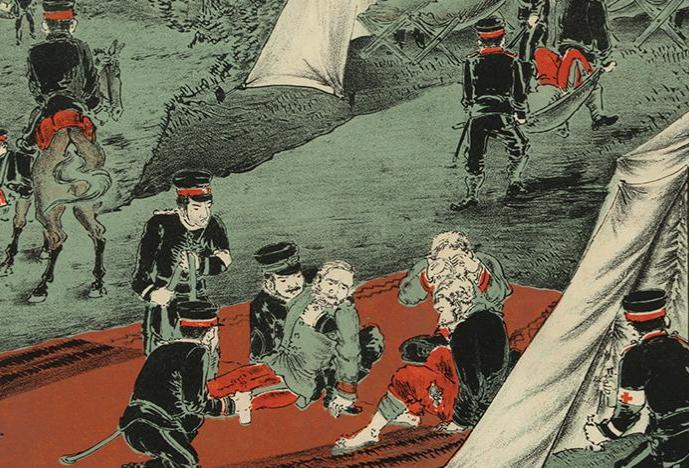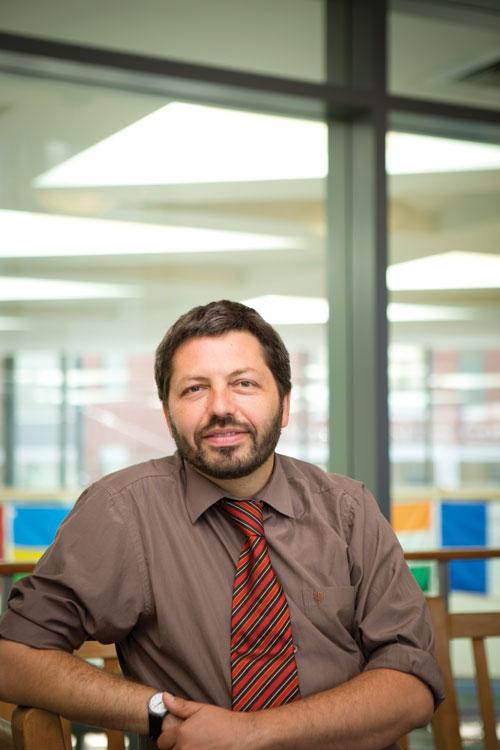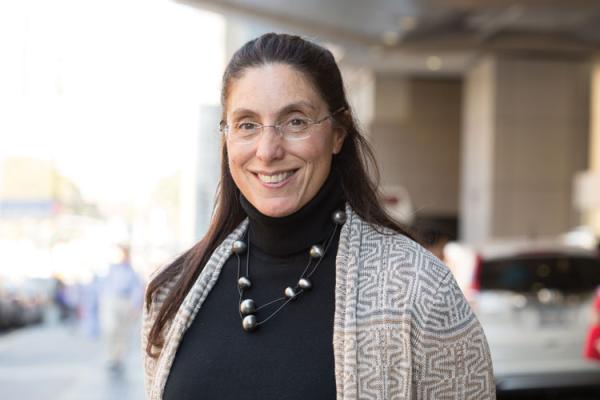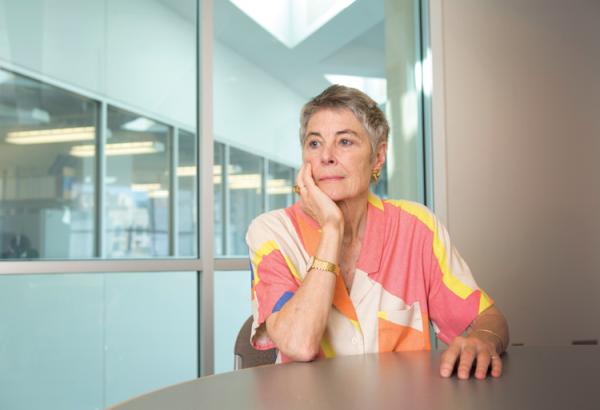In Short Supply
Can doctors who deliver medical care following disasters shift their thinking from what’s good for the one to what’s good for the many?
- Feature

Japanese Red Cross near the Yalu River 1904
When a calamity strikes and tens of thousands of people need help, the first impulse is to cry “All hands on deck!”
Not so fast, say experts in disaster relief.
“It was always thought that in a disaster there wouldn’t be time to measure the quality of the aid, and no real reason to do so,” says Michael VanRooyen, an HMS professor of emergency medicine, head of the Department of Emergency Medicine at Brigham and Women’s Hospital, and director of the Harvard Humanitarian Initiative at Harvard University. “We assumed that any care is good care. But we now know that’s not the case.”

When providing medical care in disasters, health care providers must make on-the-spot decisions about who should receive care and how much, and they must do so with the knowledge that resources are limited in every conceivable way.
To help physicians navigate these decisions, experts in disaster care have begun to systematize triage, resource management, and training. The aim: to professionalize the delivery of disaster medical care by teaching humanitarian professionals how to make evidence-based decisions that draw on their deep knowledge and past experience. Such a change, say many, could also make the delivery of such care more needs-based and more ethical.
Evolutionary Behavior
Those who have participated in humanitarian aid know all too well what can go wrong when the response is uncoordinated and doctors and nurses arrive on the scene without having been trained in disaster response.
Poor triage of acute wounds, for example, can lead to inappropriate medical care and years of suffering for the patient. This particular complication cascade revealed itself after the 2010 earthquake in Haiti. Although triage decisions addressed patients’ immediate needs, experts say they also produced hundreds of thousands of trauma cases that required postoperative care and rehabilitation that the infrastructure-strapped country still struggles to provide. Another example was the aid response to the 2015 earthquake in Nepal. That response became so unwieldy the country had to turn aid workers away, says Jennifer Leaning, an HMS associate professor of emergency medicine and the François-Xavier Bagnoud Professor of the Practice of Health and Human Rights at the Harvard T.H. Chan School of Public Health. The workers were sapping resources that were limited, including such basics as shelter, food, and water.
The realization that more is not always better hits at the heart of the ethics of giving care in a disaster.
“Doctors in the United States are conditioned to caring for individual patients and working to achieve spectacular outcomes,” says Leaning, who also directs the FXB Center for Health and Human Rights at the Harvard Chan School. “They also tend to hew to the thinking that more individual attention is better.”

“Disaster is a time of altered standards of care,” says ethicist Nir Eyal, an associate professor of global health and population at the Harvard Chan School. “The attention must shift to population-level outcomes.”
This shift to a population-based approach to delivery of health care is difficult for many Western-trained doctors and nurses, says Leaning, for it differs from the personalized care they are accustomed to providing. The trouble, she adds, begins with the first medical encounter when the health provider must attend to an individual’s needs but must do so in a manner that allows for the ongoing delivery of care to a larger group or the entire population. The health care providers must deploy limited, often dwindling, resources to deliver the greatest good to the greatest number of people.
“Keeping your focus on both the individual and the population at the same time is disorienting—and troubling,” says Leaning.
What disaster-relief scientists such as Leaning and VanRooyen are finding is that health care professionals cannot make this conceptual shift on their own. They need guidelines, best practices, and training—the very tools that would result from a systematization of disaster medical care and its protocols. This systematization is, in fact, happening, albeit slowly. Disaster care is becoming a standards-based profession, complete with recognized guidelines and best practices that are being crafted by the World Health Organization and other international aid bodies.
“This transition constitutes a remarkable innovation,” says Leaning. “We need to be moving toward a self-correcting ethical system of professionalism.”
Up Close
In 1996 when Mary Ann Hopkins ’92 headed for the U.S. office of Médecins Sans Frontières, the international humanitarian-aid organization had yet to receive the Nobel Peace Prize. In fact, its New York office employed just a handful of people. Hopkins had happened upon one of its brochures during her surgical residency in New York City and, having previously served as a foreign aid worker, decided to sign up.
They sent her to Sri Lanka, which was in the middle of a bloody, protracted civil war.
Hopkins, now an associate professor of surgery and the director for global health initiatives at the NYU Langone Medical Center, had requested an assignment outside of the active war zone. But, as she traveled from New York to eastern Sri Lanka, the conflict spread. A few weeks after she arrived at her post, the front lines came to her.
“My constant concern was that I would have too many casualties arrive at one time,” says Hopkins.
Fundamentally, aid workers are guided by the universal principles of maintaining neutrality in conflicts and providing nondiscriminatory care. Hopkins and her colleagues cared for both the victims and the perpetrators of the violence without hesitation. Hopkins’s father, Robert West Hopkins ’47, adhered to the same principles during the Korean War, when, as a lieutenant in the U.S. Navy, he served as a surgeon on the USS Repose. “When he talked about his war experiences, he talked about the need for impartiality,” Hopkins says. “ ‘You always treat everybody.’ ”
Yet limited resources in a disaster make it impossible to treat everybody. Medical aid workers must find a way, second by second, to do the most good for those who are suffering even if it means choosing to limit care to those who cannot be saved.
Such decisions require difficult choices. They also require practice.
Work to Rule
In medicine, triage, derived from the French trier, to sort, applies to initial assessments of acute patient needs, to follow-up assessments, and to decisions on the allocation of supplies and expertise.
The fundamental coding in acute triage is similar whether a patient is coming to a hospital’s emergency department or to the medical intake area in a disaster-relief zone. The degree of patients’ need for medical care is identified using a system of color codes. Black, for example, indicates patients who are unlikely to survive and should not receive treatment. Those coded red need, and receive, immediate intervention, while yellow indicates a patient whose needs are less urgent. Green indicates no care is required.
In a disaster, however, far fewer people can be helped than could be under less-trying circumstances. To make tough and troubling decisions about who will receive assistance and who will be left unattended, regardless of medical need, health care providers must train. “Decisions about life and death or medical futility are rare,” says VanRooyen, “but when they are necessary, they are distracting and difficult. So we drill.”

During Hopkins’s years of service as an emergency surgeon in conflict zones in Burundi, the Republic of the Congo, the Central African Republic, and elsewhere, she encountered patients she could not save, in some cases because the available equipment wasn’t sophisticated enough for her to perform the needed surgeries.
“You will not always be able to do what you think you should do,” says Hopkins. “That fact has persisted throughout every mission.”
A World View
While health care providers are working to establish clear triage guidelines, an increasing need for global disaster aid is propelling efforts to systematize post-disaster medical care. According to a 2014 report from the United Nations Office for the Coordination of Humanitarian Affairs, the number of people needing humanitarian assistance has doubled in the past decade, and the numbers continue to rise.
“The scale of morbidity and mortality has risen sharply,” says VanRooyen.
One reason for the increase, according to the UN report, is climate change, which is increasing the incidence and intensity of floods, hurricanes, droughts, heat waves, and other severe weather events. Between now and 2050, the report projects, climate change could displace a billion people. There also is an uptick in population movement to urban centers, which can have poor infrastructure and insufficient and unsafe housing. In addition, there are the pressing needs of ongoing political conflicts, such as the civil war in Syria.
The report also says that crisis relief funding needs have increased sixfold in the past decade. Because of this need, the ability to provide ethical and beneficial disaster care hinges not only on decisions made during acute care triage, but also on those made during the triage of limited resources, which range from the availability of surgeons like Hopkins to the use of medical supplies including painkillers, oxygen, antibiotics, and vaccines.
According to VanRooyen, vaccination against measles provides a clear example of triaging resources for the public’s health. Migrating populations need vaccinations to stay healthy. But, he says, “Immunizations for mumps, rubella, tetanus, and polio can wait. Measles will kill a third of the children in three weeks if they aren’t vaccinated.”
Not all resource-use decisions are so clear-cut. Water, for instance, must be provided to individuals in refugee camps, but only potable water is made available; supplying non-potable water as well adds risk. Aid organizations currently aim to supply the standard three liters of drinkable water per person per day. It’s a woefully small amount considering the ration must be used for cleaning cooking utensils, food preparation, personal hygiene, and drinking.
But is three liters the right amount? No one knows; it has never been rigorously studied.
“The amount comes from early work—in Biafra in the 1960s and along the Thai-Cambodian border in the 1980s,” says Leaning.
It is neither feasible nor ethical, she adds, to run a randomized clinical trial at a refugee camp to test whether refugees receiving two-and-a-half liters of water fare any differently from those receiving three.
As work continues at the organizational level to systematize disaster care, significant time is spent in the field thinking of ways to run studies. When she conducts training sessions in disaster relief, Leaning uses historical experience and anecdote as evidence for practice.

“It’s a distilled understanding,” she says, “a sort of word-of-mouth apprenticeship.”
Experts develop and incorporate best practices and the practices are folded into existing guidelines in publications such as the Sphere Handbook: Humanitarian Charter and Minimal Standards for Humanitarian Response. The book, published by the Sphere Project, which was developed by seasoned humanitarian responders from various aid organizations, sets forth standards for water and food management and health care responses and serves as a guide for the humanitarian community.
“It’s a very informative book and has increasingly become more ethics-based and focused on human rights and key principles,” says Leaning.
As of 2015, professional development for medical aid workers has included the option for global certification. The Emergency Medical Team program that is administered by WHO focuses on training medical personnel to provide integrated care in a disaster. Because of the program, WHO can now provide specific countries with rosters of qualified providers—a registry of trained professionals who have made a commitment to provide disaster care and who work to continually improve their skills. The ability to tap a cadre of skilled individuals and teams committed to disaster relief stands in sharp contrast to the traditional open calls for aid.
“The days of disaster excitement have to be over,” says Leaning. “We need dependable professionals who train and retrain, so that aid organizations can be assured that they are bringing in seasoned professionals to be part of the response.”
The Bigger Picture
While professionalizing disaster care promises to improve humanitarian aid efforts, there is a danger that too much systematization could lead to mechanistic care. Procedures and processes could become barriers to truly seeing the humans in jeopardy.
“If you are just doing the clinical and operational triage, you are going to outrage people and deny their dignity,” says Leaning. “When we talk about doing the greatest good for the greatest number in public health and medical care, the ‘good’ is life. We’re not distributing money. We’re distributing access to living.”
Elizabeth Dougherty is a Massachusetts-based science writer.
Images: Library of Congress, Prints and Photographs Division (top); Flynn Larson (Hopkins); John Soares